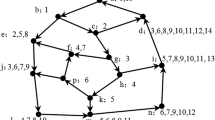Abstract
This paper proposes a new algorithm for detecting and generating simple circuits within a directed graph. Before generating all simple circuits in a directed graph, the algorithm first detects whether there is a simple circuit in directed graph, and the detection can divide the directed graph into trivial graphs or strongly connected components. In the process of detecting the existence of simple circuit, the algorithm repeatedly reduces the number of vertices in vertex set along with edge pruning. Based on depth-first traversal, we can get all simple circuits of the directed graph. Especially, instead of proceeding depth-first traversals based on all vertices, the algorithm starts with a random vertex in a strongly connected component to reduce the number of depth-first traversals, and obtain all simple circuits of this strongly connected component. The difficulty of the algorithm is to detect and delete the repeated circuits in the process of generating all simple circuits, which can reduce both the storage space and time complexity. As a result, the output of the algorithm does not contain any repeated circuits. The algorithm simplifies the edge set of directed graphs and greatly reduces the number of depth-first traversals, thereby reducing the computational complexity and improving the computational efficiency.




Similar content being viewed by others
Explore related subjects
Discover the latest articles, news and stories from top researchers in related subjects.References
Biggs N, Lloyd E, Wilson R (1986) Graph theory. Oxford University Press, Oxford, pp 1736–1936
Chu K et al (2015) Real-time path planning of autonomous vehicles for unstructured road navigation. Int J Automot Technol 16(4):653–668
Aytac A, Turaci T (2015) Vulnerability measures of transformation graph G(xy)+. Int J Found Comput Sci 26(6):667–675
Marsden A, Berry RS (2015) Enrichment of network diagrams for potential surfaces. J Phys Chem C 119(26):14702–14705
Tang M, Guan J, Deng GQ et al (2012) A new algorithm and application of solving maximum matching problem of bipartite graph. Comput Syst Appl 21(03):72–75
Tellache NEH, Boudhar M (2018) Flow shop scheduling problem with conflict graphs. Ann Oper Res 261(1–2):339–363
Kouider A et al (2017) Mixed graph colouring for unit-time scheduling. Int J Prod Res 55(6):1720–1729
Wang F, Xing KY, Zhou MC, Xu XP, Han LB (2016) A robust deadlock prevention control for automated manufacturing systems with unreliable resources. Inf Sci 345:243–256
Lima CVGC et al (2018) And/or-convexity: a graph convexity based on processes and deadlock models. Ann Oper Res 264(1–2):267–286
Chang X, Yang Y (2017) Semisupervised feature analysis by mining correlations among multiple tasks. IEEE Trans Neural Netw Learn Syst 28(10):2294–2305
Chang X et al (2017) Bi-level semantic representation analysis for multimedia event detection. IEEE Trans Cybern 47(5):1180–1197
Li Z et al (2017) Beyond trace ratio: weighted harmonic mean of trace ratios for multiclass discriminant analysis. IEEE Trans Knowl Data Eng 29(10):2100–2110
Chen WK (2015) Graph theory and its engineering applications. World Scientific Publishing, Singapore, pp 2–10
Bu YH, Wang WF, Lv XZ (2015) Graph theory and its applications. Southeast University Press, Nanjing, pp 2–3
Wang HM, Hu M, Wang T (2017) Data structures in C++. Tsinghua University Press, Beijing, pp 144–145
Mark AW (2017) Data structures and algorithm analysis in C, 2nd edn. Addison Wesley, Boston, pp 283–284
Pang C et al (2015) Topological sorts on DAGs. Inf Process Lett 115(2):298–301
Qi JH, Zhu XJ, Zhang ZB (2014) Study on circuits determination algorithm in directed graph. Comput Program Skills Maint 24:124–125
Xiong DY (1987) An efficient vector space algorithm of generating all elementary circuits in directed graph. J Electron 9(6):481–489
Wang YY, Chen P, Su Y (2008) A new algorithm to find all elementary circuits of a directed graph. J Shaanxi Norm Univ (Nat Sci Ed) 36(4):12–15
Wang YY, Chen P, Su Y (2009) An efficient algorithm of generating all elementary circuits in directed graph. Comput Appl Softw 26(12):27–29
Stepkin AV (2015) Using a collective of agents for exploration of undirected graphs. Cybern Syst Anal 51(2):223–233
Xu B, Jia RA (2002) Matrix calculation of directed cycles and relative properties of digraph. J Nanchang Univ (Nat Sci) 26(1):5–11
Yang HG, Shen DR, Kou Y, Nie TZ, Yu G (2017) Strongly connected components based efficient PPR algorithms. Chin J Comput 40(3):584–600
Author information
Authors and Affiliations
Corresponding author
Additional information
Publisher's Note
Springer Nature remains neutral with regard to jurisdictional claims in published maps and institutional affiliations.
Rights and permissions
About this article
Cite this article
Gongye, X., Wang, Y., Wen, Y. et al. A simple detection and generation algorithm for simple circuits in directed graph based on depth-first traversal. Evol. Intel. 15, 2411–2420 (2022). https://doi.org/10.1007/s12065-020-00416-6
Received:
Revised:
Accepted:
Published:
Issue Date:
DOI: https://doi.org/10.1007/s12065-020-00416-6




